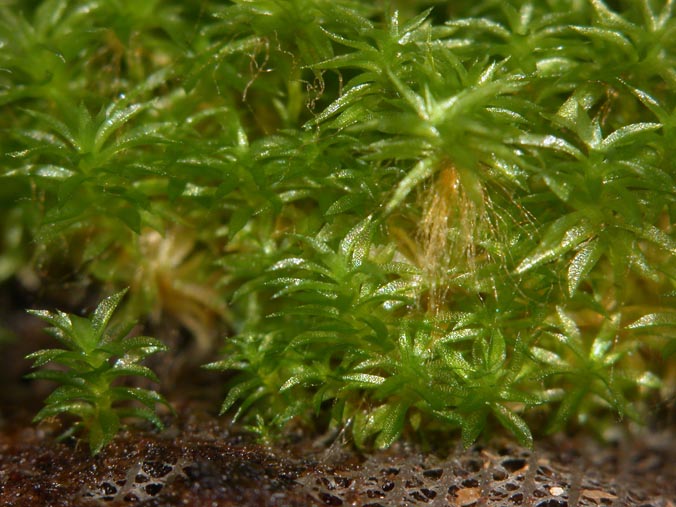- Physcomitrella patens
Taxobox
name = "Physcomitrella patens"

image_width = 240px
regnum =Plant ae
divisio = Bryophyta
classis =Bryopsida
subclassis =Funariidae
ordo =Funariales
familia =Funariaceae
genus = "Physcomitrella "
binomial = "Physcomitrella patens"
binomial_authority ="Physcomitrella patens" is a
moss (Bryophyta) used as amodel organism for studies on plant evolution, development and physiology.Model organism
Mosses share fundamental genetic and physiological processes with
vascular plants , although the two lineages diverged early in land plant evolution.Rensing, S. A., Lang, D., Zimmer, A. D., Terry, A., Salamov, A., Shapiro, H. et al. (2008). [http://www.sciencemag.org/cgi/content/abstract/319/5859/64 The "Physcomitrella" genome reveals evolutionary insights into the conquest of land by plants.] Science, 319(5859), 64-69.] A comparative study between modern representatives of the two lines can give an insight into the evolution of the mechanisms behind the complexity of modern plants. It is in this context that "Physcomitrella patens" is used as amodel organism ."Physcomitrella patens" is one of a few known
multicellular organisms with highly efficient homologous recombination. [Schaefer, D. (2002) A new moss genetics: Mutagenesis in "Physcomitrella patens". Annu. Rev. Plant Biol. 53: 477–501.] Basically, this means that researchers are able to target an exogenousDNA sequence to a specific genomic position; it is a powerful and sensitive tool to study the function ofgenes and, when combined with studies in plants like "Arabidopsis thaliana", can help to unravel major molecular trends of plantevolution .In addition, P. patens is increasingly used in
biotechnology . Prominent examples are the identification of moss geneswith implications forcrop improvement or humanhealth [Ralf Reski and Wolfgang Frank (2005): Moss (Physcomitrella patens) functional genomics – Genediscovery and tool development with implications for crop plants and human health. Briefings in Functional Genomics andProteomics 4, 48-57. [http://bfgp.oxfordjournals.org/cgi/content/abstract/4/1/48] ] and the safe production of complexbiopharmaceutical s in the mossbioreactor , developed byRalf Reski and his co-workers [ Eva L. Decker andRalf Reski (2007): Moss bioreactors producing improvedbiopharmaceutical s. Current Opinion in Biotechnology 18, 393-398. [http://www.sciencedirect.com/science?_ob=ArticleURL&_udi=B6VRV-4PNF9TF-1&_user=10&_rdoc=1&_fmt=&_orig=search&_sort=d&view=c&_version=1&_urlVersion=0&_userid=10&md5=8705ead041e2fce0709c445d37f3972e] ]The
genome of "Physcomitrella patens", with about 500MB organized in 27 chromosomes, was completely sequenced in 2006. [ [http://www.jgi.doe.gov/ JGI] ]Life cycle
Like all mosses, the life cycle of "Physcomitrella patens" is characterized by an alternation of two generations: 1) a
haploid gametophyte that producesgametes and 2) adiploid sporophyte where haploidspores are produced.A spore develops into a filamentous structure called
protonema , composed of two types of cells – chloronema with large and numerous chloroplasts and caulonema with very fast growth. Protonema filaments grow exclusively bytip growth of their apical cells and can originate side branches from subapical cells. Some side branch initial cells can differentiate into buds rather than side branches. These buds give rise to gametophores (0.5 - 5 mmGoffinet, Bernard (2005). [http://www.mobot.org/plantscience/bfna//V1/FunaPhyscomitrella.htm Physcomitrella] Bryophyte Flora of North America, Provisional Publication ] ), more complex structures bearing leaf-like structures, rhizoids and the sexual organs: femalearchegonia and maleantheridia . "Physcomitrella patens" ismonoicous , meaning that male and female organs are produced in the same plant. If water is available flagellate sperm cells can swim from the antheridia to an archegonium and fertilize the egg within.The resulting diploid zygote originates a sporophyte composed of a foot, seta and capsule, where thousands of haploid spores are produced bymeiosis .Distribution
"Physcomitrella patens" is widely distributed in the
northern hemisphere .References
External links
* [http://www.mossgenome.org The moss genome consortium homepage]
* [http://www.cosmoss.org cosmoss.org - moss transcriptome and genome resource] including [http://www.cosmoss.org/cgi/gbrowse/physcome genome browser]
* [http://moss.nibb.ac.jp The Japanese Physcomitrella transcriptome resource (Physcobase)]
* [http://www.ncbi.nlm.nih.gov/sites/entrez?db=genomeprj&cmd=Retrieve&dopt=Overview&list_uids=12940 The NCBI Physcomitrella patens genome project page]
* [http://genome.jgi-psf.org//Phypa1_1/Phypa1_1.home.html JGI genome browser]
* [http://www.bio-pro.de/en/region/freiburg/magazin/02551/index.html The moss Physcomitrella patens gives insights into RNA interference in plants]
* [http://www.bio-pro.de/en/region/freiburg/magazin/00728/index.html Small but Important: Physcomitrella patens]
Wikimedia Foundation. 2010.
